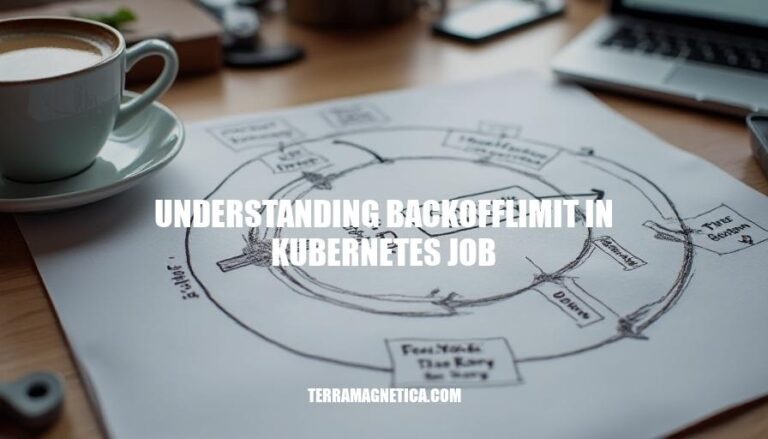


In Kubernetes, the backoffLimit parameter in a Job specification defines the maximum number of retries for a failed job before it is considered failed permanently. This is crucial for managing job retries and failures because it helps prevent infinite retry loops, conserves resources, and ensures timely error detection and handling. Understanding backoffLimit is essential for maintaining the stability and efficiency of your Kubernetes workloads.
In Kubernetes, the backoffLimit field in a Job specification sets the maximum number of retries for a Job. If a Pod fails, Kubernetes will attempt to restart it. The backoffLimit determines how many times Kubernetes will retry the Job before considering it failed and stopping further attempts. This helps manage job execution by preventing endless retries and allowing for better resource utilization and failure handling.
In Kubernetes, the backoffLimit parameter in a Job specifies the maximum number of retries for a failed pod before the Job is marked as failed. Here’s how it works:
Pod Failure and Retry: When a pod in a Job fails, Kubernetes will attempt to restart it. The number of retries is controlled by the backoffLimit.
Exponential Backoff: Kubernetes uses an exponential backoff strategy for retries. This means that the time between retries increases exponentially. For example, if the initial retry interval is 10 seconds, the next retry will be after 20 seconds, then 40 seconds, and so on.
Limit Reached: If the pod continues to fail and the number of retries reaches the backoffLimit, the Job is marked as failed, and no further retries are attempted.
This mechanism helps manage resources efficiently and prevents endless retry loops for persistently failing jobs.
backoffLimit in a Kubernetes JobUnderstand backoffLimit:
backoffLimit specifies the number of retries before considering a Job as failed.Set Up Your Kubernetes Cluster:
kubectl configured.Define the Job YAML:
Configure backoffLimit:
backoffLimit field under the Job spec.Apply the Configuration:
kubectl apply -f <your-job-file>.yaml to create the Job.apiVersion: batch/v1
kind: Job
metadata:
name: example-job
spec:
template:
spec:
containers:
- name: example
image: busybox
command: ["sh", "-c", "exit 1"]
restartPolicy: Never
backoffLimit: 4
backoffLimit: Choose a value that balances retry attempts and resource usage.restartPolicy: Never: Ensures Pods are not restarted automatically by the kubelet.kubectl get jobs to understand retry behavior.: Kubernetes Documentation
: Bobcares Guide
The backoffLimit in Kubernetes jobs specifies the number of retries before a job is marked as failed. Here’s how it impacts job execution:
Job Reliability:
backoffLimit: Allows more retries, which can be beneficial for transient errors. However, it may lead to prolonged job execution times if the errors are persistent.backoffLimit: Reduces the number of retries, leading to quicker failure detection. This is useful for non-retriable errors, ensuring resources are not wasted on futile retries.Resource Utilization:
backoffLimit: Can lead to higher resource consumption due to repeated job attempts, potentially causing resource contention.backoffLimit: Optimizes resource usage by limiting retries, freeing up resources for other tasks.Scenarios for Adjusting backoffLimit:
backoffLimit to allow more retries, improving the chances of job completion.backoffLimit to avoid unnecessary retries, conserving resources.backoffLimit based on the job’s importance and error nature to balance reliability and resource efficiency.Here are some steps to troubleshoot common issues related to backoffLimit in Kubernetes jobs:
Check Pod Logs:
kubectl logs <pod-name> to view the logs of the failed pods. This can help identify the root cause of the failure.Describe the Job:
kubectl describe job <job-name> to get detailed information about the job, including events and reasons for pod failures.Inspect Events:
kubectl get events --sort-by=.metadata.creationTimestamp to see recent events. Look for events related to your job or pods.Adjust Backoff Limit:
backoffLimit to allow more retries. For example:apiVersion: batch/v1
kind: Job
metadata:
name: example-job
spec:
template:
spec:
containers:
- name: example
image: busybox
command: ["sh", "-c", "exit 1"]
restartPolicy: Never
backoffLimit: 5
Check Resource Constraints:
kubectl describe pod <pod-name> to check if there are any resource-related issues.Pod Failure Policy:
Common Errors:
Fine-Tune Backoff Policy:
These steps should help you diagnose and resolve issues related to backoffLimit in Kubernetes jobs.
Backoff limit in Kubernetes jobs is crucial for efficient job management as it determines how many times a pod will be retried before being considered failed.
A well-configured backoff limit can prevent resource waste and ensure reliable job execution. Here are the key points to consider:
Troubleshooting common issues involves checking pod logs, describing the job, inspecting events, adjusting backoff limit, checking resource constraints, and understanding pod failure policy.
Proper configuration of backoffLimit is essential for efficient job management in Kubernetes. By understanding how to adjust this parameter based on specific scenarios, you can ensure reliable job execution while minimizing resource waste.